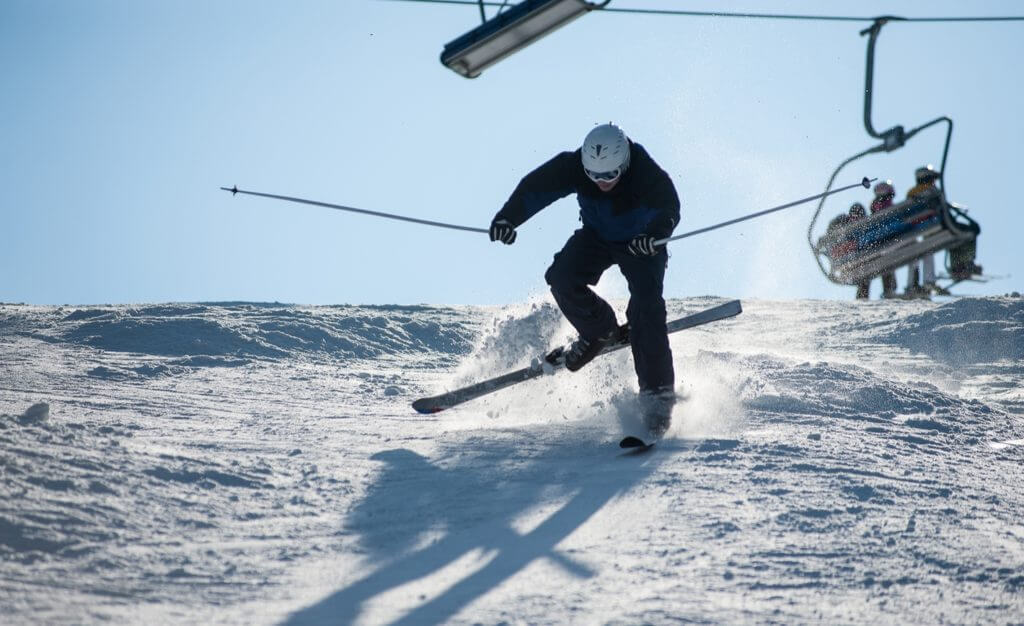’Tis the season of ski resort injuries: of the roughly 10 million Americans who ski or snowboard annually in the United States, some 600,000 injuries are reported annually, according to a Johns Hopkins University School of Medicine report. Nearly 20 percent of those are head injuries, which most often happen when skiers or snowboarders hit inanimate objects like trees or the ground. All in all, over the past 10 years, an average of 38 people per season have died while skiing or snowboarding at a ski area in the United States.
While your lift tickets carry printed warnings and waivers of the resort’s liability, there are definitely legal exceptions to your expected “inherent risk” on the slopes.
Danger from above
According to court documents, on February of 2015, Chicago paramedic Tom Dubert was skiing down the Flying Dutchman, an intermediate-level “blue” run at Colorado’s Keystone Resort. It was the last run of a family and friends’ getaway, and Dubert had stopped on the mountain for just a moment in order to adjust his goggles. Moments later, a Colorado man snowboarding uphill of Dubert and attempting to pass him “at a high rate of speed” slammed into Dubert from behind, separating his shoulder.
After a two-day trial in October, a Summit County jury ordered snowboarder Casey Ferguson to pay $263,454.44 in damages—compensation for Dubert’s expenses and two months’ work lost while on mandatory medical leave.
Collisions between skiers (or boarders), while nearly always accidents, can still involve liability if a court finds evidence of negligence or recklessness. That’s why the National Ski Areas Association posts its Skiers Code of Responsibility on your lift ticket, and throughout resorts. Some of the most relevant guidelines are:
- Always stay in control, and be able to stop or avoid other people or objects.
- People ahead of you have the right of way. It is your responsibility to avoid them.
- You must not stop where you obstruct a trail, or where you are not visible from above.
- Whenever starting downhill or merging into a trail, look uphill and yield to others.
A skier or snowboarder who hits you in violation of any of these guidelines may find themselves in serious trouble. After a New Jersey man was allegedly killed in a collision at Breckenridge Ski Resort in Colorado, his wife filed a suit which charged a New Hampshire teen, his mother, his ski coach, his team, and the sponsoring ski foundation with negligence, and sought compensatory damages “that far exceed $75,000” plus litigation costs.
Not all states use a negligence standard for determining fault; some defer to the stricter recklessness standard. That term is used for when a person carried out actions they knew were likely to be unsafe; in other words, they understood and appreciated the risk, but went right ahead and did it anyway. In a state following a recklessness standard, recovering damages from another skier or snowboarder is contingent upon proving that the other person acted recklessly or was grossly negligent.
When the resort is the plaintiff
Most states with thriving ski industries have passed laws that prevent a skier or snowboarder from suing the resort when an accident arises out of the inherent risks of the sport. While each state’s law is different, most define the risks of skiing as the “integral” or the “reasonably obvious, expected, and necessary” aspects of skiing or snowboarding. This type of law protects the resort from most claims of negligence.
Nonetheless, resorts can find themselves in court. In 2007, two people sued Vail Associates after they sustained injuries—within a week of each other—when they inadvertently skied over an unmarked boundary at Beaver Creek, fell off a 19-foot retaining wall, and dropped onto a paved access road. The appellate court found there was a legitimate dispute as to whether the boundary was adequately marked. Both cases later settled.
Meanwhile, in 2014, a California jury awarded $4 million to a 35-year-old woman for a ski accident at Mountain High Resort that left her paralyzed from the chest down. The former veterinarian said she never saw signs warning of terrain features, and testified that she unexpectedly flew off a terrain change and landed on her back.
And in 2015, Maine’s Sugarloaf Resort settled with a Delaware family for an undisclosed amount following a 2010 chairlift failure that caused the family’s chairs to plummet 30 feet. According to the lawsuit, former Delaware state senator Michael Katz suffered a traumatic brain injury and his two daughters suffered vertebra and head injuries.
Non-skiing injuries and resort liability
For injuries off the slopes, a ski resort may be held liable like any other company. In 2010, a Bellingham, WA, jury awarded a 66-year-old woman $335,000 in her lawsuit against Mt. Baker Ski Area following a bizarre 2008 accident: as the woman was reading a book outside the resort’s lodge, an accumulation of ice and snow slid from the roof and sent ice and snow crashing down upon her, rendering her a paraplegic.
In cases of slipping and falling on a ski resort’s sidewalk, in a resort’s building, or even while walking along the bottom of a ski trail on the way to a lift, consider speaking with an attorney about a slip-and-fall claim—most personal injury lawyers offer free consultations.
Published in AvvoStories




